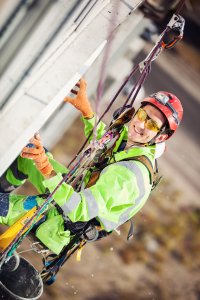 Whilst decorating spaces as diverse as schools, offices and listed buildings it goes without saying that height will feature to a fair extent. Despite the (occasionally) great views, it has to be admitted that this part of the work carries its risks. So, in order to avoid a job turning into the opening sequence to an episode of Casualty, and before we hear the worried tones of Charlie Fairhead in the distance, let’s look at working at height with safety in mind.
Whilst decorating spaces as diverse as schools, offices and listed buildings it goes without saying that height will feature to a fair extent. Despite the (occasionally) great views, it has to be admitted that this part of the work carries its risks. So, in order to avoid a job turning into the opening sequence to an episode of Casualty, and before we hear the worried tones of Charlie Fairhead in the distance, let’s look at working at height with safety in mind.
Stats and Regs
In the UK, falls from height cause approximately 50 deaths at work each year and a further 4,000 injuries. Now, we don’t want any of us or any of you to become one of those statistics, so it’s worth a moment’s consideration. A British Standard as part of the Work at Height Regulations was released in 2005. The Management of Health and Safety at Work Regulations 1999 are also key, as they require risk assessments to be completed. The following food for thought is based on the HSE advised hierarchy of control:
-
Elimination (or avoiding working at height)
This does not mean that you should only paint a school classroom up to where the children’s eye-line ends, no matter how tempting this may be. Obviously painting upper levels and ceilings requires working at height, but perhaps it’s worth the extra two seconds of effort to get back down from the ladder when the area being covered could, in fact, be reached from the ground…
-
Substitution (or changing the thing that is hazardous)
Since we can’t replace a three story external wall with something more resembling a dolls house, there is a limited substitution that can take place for a decorator working at height. All we’d say here is to simply be sensible in the means by which you are at height, for example when a ladder can be replaced by a platform.
-
Engineering controls (or machines to stop you from falling)
Obviously, this element of protection is dependent on the job. Restoring the external fascia of a listed building would be a sensible time to use a tower or lift. However, try to cram one of these pieces of kit into a second-floor new media office to repaint their internal walls and you may raise an eyebrow or two.
-
Administrative Controls (or the dreaded risk assessment)
It’s been a buzz phrase for many years, but there is often some confusion about what a risk assessment is. It does not have to be a complicated document but is simply there to help a business owner, manager or project leader make sure that they have considered all potential dangers to themselves and their staff during a specific task, event or project.
-
Personal protective clothing and equipment (or getting ‘all the kit’)
When working at extreme height for a redecoration or refurbishment, fall restraint systems usually include anchor points and safety harnesses or lanyards. However, for office maintenance jobs or school refits, we’d argue that the most personal way to keep safe is really the human decisions that are made in the process of decorating. This is something that should be instilled by training.
Sensible working at height is often based on common sense. Just as you wouldn’t make your morning toast in the bathroom or reposition roof tiles in gale force winds while wearing stilettos, by not leaning that inch too far from a platform or ladder simply to avoid the two minutes it takes to reposition the support will protect you from the realms of the Casualty opening sequence. So try to remember the theme tune and think of us when you need someone to go up that ladder for you.
We are commercial painting and decorating contractors, serving London, Essex, Cambridge and the Home Counties.
We’d love to talk more about your commercial project. Contact us for a free quotation.
Take a look at some of our previous projects.

